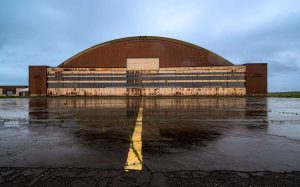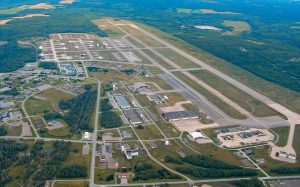Next steps
Loring Air Force Base, established in 1947 when Harry Truman was president, was named for Charles J. Loring Jr., a World War II fighter pilot who later served in the Korean War. He rose to the rank of major and was killed in action in Korea in November 1952, posthumously receiving the Medal of Honor.
The base was closed in 1994 and later redeveloped by the Loring Development Authority as an industrial park known as the Loring Commerce Centre anchored by Loring International Airport.
A 1995 plan to repurpose the former base evaluated Loring’s aviation assets, and stayed in a holding pattern for over two decades. Not until 2019 and 2021 did strategic plans identify aviation as a promising long-term development opportunity.
Today, Vermont-based consulting firm Dubois & King is working on a plan to convert Loring into a public airport under contract from the Loring Development Authority, funded by $540,000 out of the $740,000 Pentagon grant.
The process is expected to take around 12 months and will involve participation from the state and local stakeholders, as well as input from the FAA, according to DECD’s Garland.
“Activating the Loring Airport,” she predicts, “will complement the airports in Aroostook County and enhance the region as a whole.”
Once Loring is recognized as a public airport, it would be followed by a capital improvement to be implemented in phases over the next five to 10 years, Levesque explains.
Space ambitions
Loring redevelopment ambitions include putting Maine on the map in the new space economy by supporting activities such as the testing and development of drones and autonomous land vehicles.
Loring could also play a key role in the envisioned Maine Space Complex. Still in the early planning stages, the complex would consist of a virtual Space Data and Advanced Analytics Center, a New Space Innovation Hub at Brunswick Landing with a hub or branch at Loring Commerce Centre, and coastal launch sites and services. Horizontal satellite launches from Brunswick Landing and Loring would be part of that.
Keeping an eye on Loring’s trajectory is Sascha Deri, founder and CEO of Brunswick Landing-based bluShift Aerospace. The nine-employee rocket startup made history at Loring in January 2021 with the world’s first commercial launch of a rocket powered by biofuel.
“Right now, our plan is to do vertical launches off the coast of Maine, but it’s possible that our engines could be used in horizontal launch vehicles at some point in the future,” Deri says. “We could see that future customers of ours could incorporate our engine technology into their horizontal launch vehicles strapped underneath planes, and Loring has a uniquely long runway that would be particularly well-suited to support this type of launch.”
Once Loring gets cleared for take-off as a public airport, the sky may be the limit for bluShift and other innovators seeking their fortunes in a galaxy far, far away.


